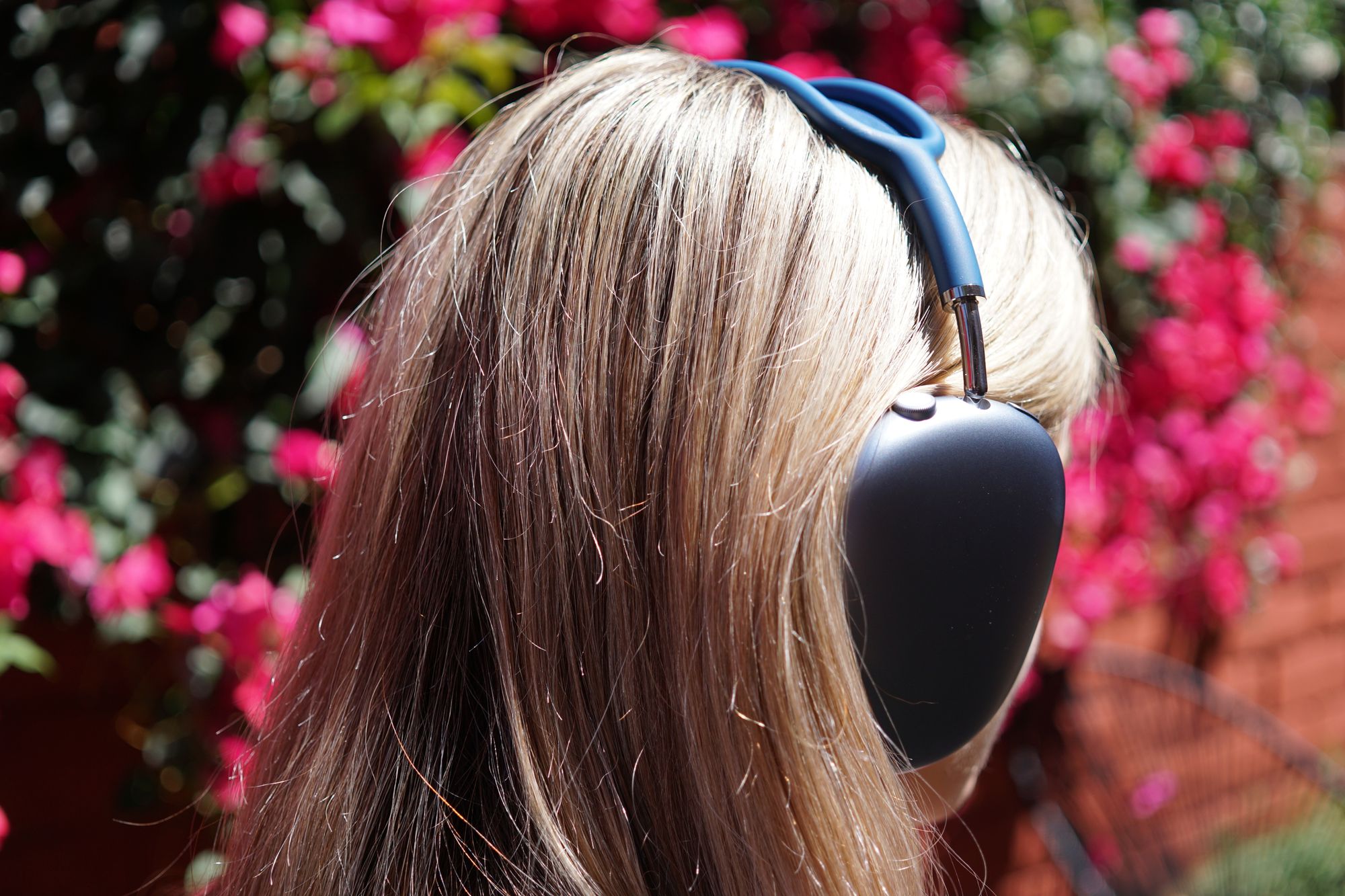Apple’s $550 flagship headphones have a problem: They can malfunction, or suddenly stop working entirely, because of users’ sweat, or because of the condensation that can build up when people exercise in them or wear them for long periods of time.
Reddit, YouTube, Twitter, and Apple’s forums are full of people complaining about condensation problems, in which sweat or humidity forms into water droplets inside the over-the-ear headphones, leaks through the speaker holes of the headphones, and causes water damage inside of them. One particularly aggrieved customer has taken to calling this “Condensation Death” in a series of Reddit posts.
“AirPods Max condensation won’t damage the drivers!!”
— Michael (@NTFTWT) July 5, 2022
The condensation in question: pic.twitter.com/rUKwBOWYjk
This condensation issue was reported almost immediately after AirPods Max were released in December, 2020, but the problem seems to be particularly pronounced three years into the AirPods Max’s lifecycle and during the hottest summer on record. A class-action lawsuit about the problem that’s been winding its way through California for the last two years alleges “a latent and material defect [that] causes condensation to accumulate inside the ear cups of the AirPods Max, often after only an hour or several hours of normal use.”
The plaintiffs in that case have been negotiating a settlement with Apple over the previous several months. Outside of the lawsuit, Apple has not publicly acknowledged the issue. Its lawyers told that court, however, that “Apple repeatedly tells customers that its new high-end, studio quality AirPods Max headphones ‘aren’t waterproof or water resistant’ and ‘not to get moisture in any openings.’”
Crucially, Apple’s lawyers also do not attempt to argue that condensation doesn’t end up inside of AirPods earcups; instead, they argue it's simply "more noticeable" than it is in other brands of over-the-ear headphones: "Unlike other over-ear headphones, Apple’s AirPods Max ear cups are magnetic and removable, making any moisture retained from body heat around the ear (or 'condensation') more noticeable to users when they remove the ear cups."
Apple's lawyers also dispute what “normal use” of AirPods Max are and argue, essentially, that the plaintiffs (and therefore their customers) should be far more careful about exercising and/or walking while wearing AirPods Max:

“Although Plaintiff says the ‘condensation’ can occur after ‘normal use’, he does not claim that the issue is widespread, and his own allegations suggest that the issue typically occurs when users exercise outdoors with or wear their AirPods Max for hours at a time,” they wrote. “For example, Plaintiff himself noticed moisture in his AirPods Max ear cups while ’taking a walk’ outside … while he omits details about that ‘walk’ (declining to say, e.g., whether it was an arduous hike up the hills of San Francisco to Twin Peaks), the excerpts of online forum comments that Plaintiff cites show that users who claim to have experienced water damage often were exercising with or wearing their headphones for prolonged periods.”
Apple did not respond to a request for comment. The lawyers for the plaintiffs of the class action lawsuit also did not respond to a request for comment.
Regardless of how the lawsuit ultimately turns out, it is clear that, at the very least, the condensation issue has become an obsession and topic of concern among Apple’s customers.
There are hundreds of posts on the AirPods Max subreddit that mention “condensation” in posts with titles like “AirPods Max broke after 5 weeks,” “The whole condensation issue is giving me so much anxiety about buying the Max,” “Condensation problem,” “Does anyone else have condensation issues,” “Let’s talk condensation once again,” “Remove ear pads and wipe the condensation after EVERY use!,” “cleanup of condensation corrosion,” “3000th Condensation Post,” “Condensation Tape Fix?,” and so on. (There is also a post called “raise your hand if you’ve never had the condensation problem.”) There are dozens of photos of sweaty AirPods Max from users wanting to show that, indeed, sweat does pool inside the headphones’ ear cups. Similar posts are all over the MacRumors forums and Apple’s official forums.
The issue has also turned some customers, journalists, and Redditors into amateur materials scientists and biologists. The general consensus among users is that the problem is that the ear cups are made of aluminum, and that air flow into the cups is blocked while a user is wearing them. The aluminum stays cooler than the general air (or a person’s head), which creates humidity and causes condensation.
Or something like that.
The headphones review site Headphonesty cites a website called DehumidifierReviewsHQ, which talks about condensation on aluminum windows. Forbes points out that aluminum is a “poor insulator” which “likely creates the condensation problem.” One Redditor, meanwhile, cites the concept of “insensible water loss,” in which people lose moisture through their skin even if they don’t feel like they are sweating; they cite a peer-reviewed study on the National Institutes of Health’s PubMed to ostensibly point out that this problem can become worse with age.
“If you want to experience it yourself, put your hand into a rubber or vinyl glove and see how quickly it starts to feel wet, even in a cold environment when your sweat glands shouldn’t be activated. Any part of your body sealed will become damp,” they wrote. “It’s really interesting that this problem seems to affect specific people that in some cases have gone through several APMs [Air Pods Max] via AppleCare and yet some like myself have never had any issues. Perhaps this is partially explained by variance in insensible water loss between individuals.”
Day 2 of testing out the condensation issue with my AirPods Max. Used them for my 7 hour stream session and the condensation is actually really bad. The liquid is all over the internal drivers. pic.twitter.com/mUMbiJrWtH
— 🦍Mez 💎🙌🏻 (@Mezxxii) January 4, 2021
A pinned post on the AirPods Max subreddit, meanwhile, explains “most hardware issues originate from condensation issues,” then adds that this can lead to “AirPods turning off randomly, refusing to connect, refusing to play audio, needing restarts and factory resets to work, losing audio quality,” and a few other problems. The user uploaded a video in which they remove the headband from the AirPods and shove a rubbing alcohol-soaked cotton swab into a connection hole.
One of the moderators of the subreddit told me that condensation is a constant topic of conversation, and that “some users are taping the pin hole to prevent it or [are] taking the headband off to clean the connections which I don’t believe we should have to do to keep the headphones safe.”
“When I wear them a lot, they do show condensation but this hasn’t caused any issues and mine to this day are working fine,” they added. “I do honestly believe Apple should look into this and they probably are because a lot of people have been affected by this issue and caused their headphones to break.”
So, what the hell is actually happening here?
Justin Ashford, a repair industry consultant and repair YouTuber, told me that condensation issues are “inherent to over-the-ear headphones,” not just AirPods Max. But what is actually happening here remains a mystery, albeit one that Ashford has a few theories about.
“I’ve been putting my ear to the ground trying to figure out what’s happening here,” for the last few years, he said. Given the number of forum posts, YouTube videos, and Reddit posts about the issue, Ashford said that he’d normally expect an issue like this to be what he calls a “scaleable repair,” the kind of defect or widespread issue that keeps independent repair shops in business.
Examples of scalable repairs are “Touch Disease” on the iPhone 6 Plus, which caused the touchscreens on the phones to work intermittently or not at all due to imperceptible bending caused over years of putting a phone into one’s pockets. Apple ignored this problem for years, faced a class action lawsuit in which it denied a problem existed, then ultimately decided to admit the issue and reimburse customers for repair costs. In the case of touch disease, iPhone repair professionals were able to identify a specific, Logic Board-level defect that caused the problem, and made lots of money fixing them. A separate, unrelated issue with the Audio IC (integrated chip) in the iPhone 7 and iPhone 7 Plus caused “Loop Disease,” which broke the phone’s microphone. Fixing this similarly kept lots of repair shops in business.
“Audio IC went bananas. Repair shops were making hundreds of thousands of dollars on that one repair,” Ashford said. “If there’s a really big issue, you’re going to find there’s a market for that scalable repair, something that will keep your shop going.”
"How many of these are being sent back to Apple and people are being told ‘Go Fuck Yourself?’"
But few repair pros I contacted had even heard of the condensation problem. Ashford notes that there are basically no water damaged AirPods Max for sale on eBay, nor any sold listings (which would be an indicator of a potentially widespread problem). Secondly, Ashford, who works regularly with aftermarket parts wholesalers, said he’s not aware of any who are making or selling AirPods Max logic board parts. “When it comes to these scalable repairs, the moment we start to see the problems we start to see the components for sale,” he said.
“So all the industry signs that this is a big problem are pointing to no,” he said. “It’s not an issue.”
“If that’s the case, though,” he continued, “then why in the fuck are so many people bitching and moaning about this online? We have to be cognizant of that and be sympathetic to that. We have to believe the people who are saying this is an issue.”
Ashford’s theory is that AirPods Max actually do have condensation problems, but that because they are a relatively new product and because there is not a mature repair market for them, people are largely just taking them back to the Apple Store when they run into the issue.
“I have absolutely, 100 percent seen liquid [from condensation] inside the driver area, Ashford said. The driver refers to the speaker part of the headphones “There’s water inside of a fucking electronic that should not have it in there. When those two go together, there are problems. My opinion is people are sending these back to Apple. How many of these are being sent back to Apple and people are being told ‘Go Fuck Yourself?’ We’ve seen it with other issues [like Touch Disease].”
“What we’re missing, right now, is solid-ass proof,” he added.


